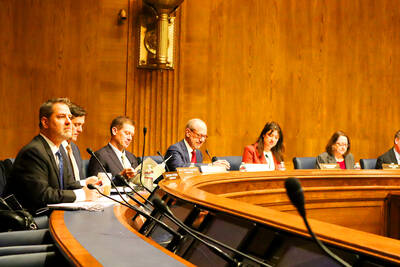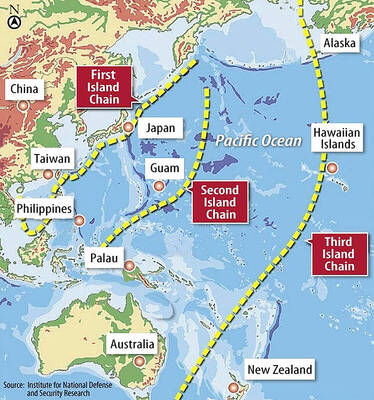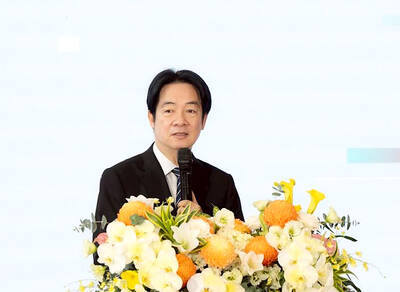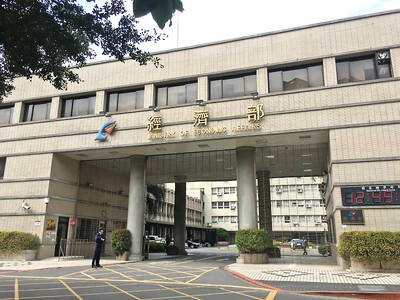North and South Korea yesterday resumed top-level talks aimed at avoiding a threatened military clash, even as Seoul accused Pyongyang of undermining the process with provocative naval and land deployments.
The South Korean Ministry of Defense said the North had doubled its artillery units at the border and deployed two-thirds of its total submarine fleet — or about 50 vessels — outside their bases.
“The North is adopting a two-faced stance with the talks going on,” said a ministry spokesman, who described the scale of the submarine movement as “unprecedented.”

Photo: Reuters
“We take the situation very seriously,” he added.
The discussions at the border truce village of Panmunjom resumed in the afternoon after a marathon negotiating session the night before.
Analysts saw the decision to keep talking as a positive sign, with the presidential Blue House in Seoul saying the two sides would “continue to narrow down differences.”
However, the gaps to be bridged are daunting, with both militaries on maximum alert and flexing their weaponry across a border that has already seen one exchange of artillery fire.
While the North moves around subs and artillery units, South Korean and US fighter jets have been carrying out simulated bombing sorties not far from the border.
Pyongyang is threatening a concerted military attack unless Seoul switches off banks of loudspeakers that have been blasting high-decibel propaganda messages into North Korea for the past week.
Seoul says Pyongyang must first apologize for landmine explosions that maimed two members of a border patrol earlier this month. It activated the loudspeakers in retaliation.
The North denies any role in those blasts and is extremely unlikely to apologize, while the South will not accept a compromise that might be seen to reward Pyongyang’s belligerence.
“The two sides may be able to come up with a statement in which some sort of ‘regret’ is expressed without explicitly naming the North,” said Jeung Young-tae, an analyst at the Korea Institute for National Unification in Seoul.
“But I don’t think such a vague statement will work this time,” Jeung said, stressing that the case of the maimed soldiers — both of whom lost legs — had become an emotional issue in the South.
“So I think the best outcome of this meeting will be an agreement for another high-level meeting in the future, such as defense ministerial talks,” he added.
That would leave open the issue of the propaganda broadcasts, which Seoul has vowed to continue in the face of an ultimatum from Pyongyang to desist or face military action.
Despite Pyongyang’s past record of making dramatic, but largely unrealized threats, the ultimatum sent tensions soaring to their highest level for years.
The negotiations in Panmunjom, where the 1950-1953 Korean War ceasefire was signed, are being led by South Korean National Security Adviser Kim Kwan-jin and his North Korean counterpart, Hwang Pyong-so — a close confidant of North Korean leader Kim Jong-un.
They are the highest-level inter-Korean talks to take place for nearly a year — a reflection of the seriousness of the situation.
“The two sides had wide-ranging discussions on ways to settle the recently developed situation and to improve inter-Korean relations down the road,” South Korean presidential spokesman Min Kyung-wook said after the night-long first session.
UN Secretary-General Ban Ki-Moon, a former South Korean foreign minister, welcomed the decision to stay at the negotiating table, urging both sides to “redouble” their efforts.
South Korea said the initial request for talks had come from the North, despite its aggressive rhetoric and military posturing of recent days.
On the orders of Kim Jong-un, the North Korean People’s Army has been in a “fully armed, wartime state” since Friday.

LIMITS: While China increases military pressure on Taiwan and expands its use of cognitive warfare, it is unwilling to target tech supply chains, the report said US and Taiwan military officials have warned that the Chinese People’s Liberation Army (PLA) could implement a blockade within “a matter of hours” and need only “minimal conversion time” prior to an attack on Taiwan, a report released on Tuesday by the US Senate’s China Economic and Security Review Commission said. “While there is no indication that China is planning an imminent attack, the United States and its allies and partners can no longer assume that a Taiwan contingency is a distant possibility for which they would have ample time to prepare,” it said. The commission made the comments in its annual

DETERMINATION: Beijing’s actions toward Tokyo have drawn international attention, but would likely bolster regional coordination and defense networks, the report said Japanese Prime Minister Sanae Takaichi’s administration is likely to prioritize security reforms and deterrence in the face of recent “hybrid” threats from China, the National Security Bureau (NSB) said. The bureau made the assessment in a written report to the Legislative Yuan ahead of an oral report and questions-and-answers session at the legislature’s Foreign Affairs and National Defense Committee tomorrow. The key points of Japan’s security reforms would be to reinforce security cooperation with the US, including enhancing defense deployment in the first island chain, pushing forward the integrated command and operations of the Japan Self-Defense Forces and US Forces Japan, as

‘TROUBLEMAKER’: Most countries believe that it is China — rather than Taiwan — that is undermining regional peace and stability with its coercive tactics, the president said China should restrain itself and refrain from being a troublemaker that sabotages peace and stability in the Indo-Pacific region, President William Lai (賴清德) said yesterday. Lai made the remarks after China Coast Guard vessels sailed into disputed waters off the Senkaku Islands — known as the Diaoyutai Islands (釣魚台) in Taiwan — following a remark Japanese Prime Minister Sanae Takaichi made regarding Taiwan. Takaichi during a parliamentary session on Nov. 7 said that a “Taiwan contingency” involving a Chinese naval blockade could qualify as a “survival-threatening situation” for Japan, and trigger Tokyo’s deployment of its military for defense. Asked about the escalating tensions

The Ministry of Economic Affairs said it plans to revise the export control list for strategic high-tech products by adding 18 items under three categories — advanced 3D printing equipment, advanced semiconductor equipment and quantum computers — which would require local manufacturers to obtain licenses for their export. The ministry’s announcement yesterday came as the International Trade Administration issued a 60-day preview period for planned revisions to the Export Control List for Dual Use Items and Technology (軍商兩用貨品及技術出口管制清單) and the Common Military List (一般軍用貨品清單), which fall under regulations governing export destinations for strategic high-tech commodities and specific strategic high-tech commodities. The